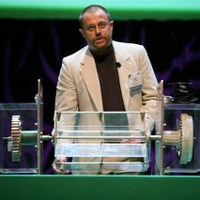
Hydrovolts founder Burt Hamner ’83, announced today that a team from Hydrovolts and students from the Harvard College Engineering Society (HCES) will collaborate to produce a variety of small floating turbines that make renewable energy from water currents in canals and the ocean.
The project is supported by the Harvard School of Engineering and Applied Sciences (SEAS) and by the Constitution Marina in Boston Harbor.
Hydrovolts is producing portable renewable energy generators powered by water. These floating hydrokinetic turbines turn canals and spillways into local power plants, tapping an overlooked global resource of clean energy for local use.
The Hydrovolts turbine is also able to make power even from slow ocean currents, enough to charge batteries. Hydrovolts has a development agreement with the Woods Hole Oceanographic Institution (WHOI) and demonstrated its prototype Flipwing turbine there in June 2010.
The first Harvard student project is to develop a new turbine for WHOI that will make marine renewable energy for remote instruments deep in the ocean. These instruments are now powered by batteries, and changing the batteries is very expensive.
Robert Howe, Abbott and James Lawrence Professor of Engineering and Associate Dean for Academic Programs at SEAS, says, “This will be one of SEAS’ signature projects demonstrating our commitment to practical engineering education and industry exposure for our students. It is exciting to learn of the potential impact that this project may bring about in reducing the cost of replacing batteries in such remote areas.”
Barry Griffin ’71, a Harvard alum who is serving as a lecturer at SEAS, will coordinate and help the student engineers design, build, install and measure hydrokinetic turbines that make renewable energy from fast water currents around New England. “This is a practical engineering project with high commercial value,” says Griffin. “Even little Hydrovolts turbines can make enough power for batteries if they are in a fast water current.”
At Constitution Marina in Boston Harbor, General Manager Tom Cox already figured that out. He contacted Hydrovolts to ask about turbines that can make renewable energy from the water currents created by the Charles River locks and pumps. After talking with Hydrovolts he realized that their small turbines could towed behind sailboats and make power for their batteries. “All boats need power,” says Cox. “Any sailboat with a strong wind can tow this turbine and make renewable power . Here at the marina we can test these turbines right in the harbor.”
Burt Hamner, CEO of Hydrovolts, is excited about the new approach to collaboration. “Instead of working with interns or class projects, where students come and go every semester, we are working with the Harvard College Engineering Society and its members. They can start with us as freshmen and stay involved as long as they want. And they can test their prototype turbines right at the Constitution Marina near Harvard, and in the old watermill sites around New England.”



